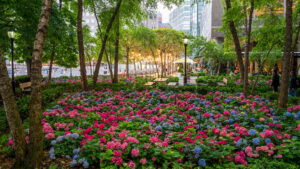Let’s get into the ABC’s of hydrangeas! There are a lot of terms that can be helpful to know when working with your hydrangeas in the garden. We’ve broken down the ones we feel are important. Let’s get into it!

Soil with a pH of less than 6.0 is called acidic soil. Hydrangeas growing in more acidic soils are less able to absorb nitrogen, phosphorus, and potassium, and will produce blue hydrangea blooms. If you have acidic soil and prefer a pink hydrangea, see our Planting & Care section for tips.
Soil with a pH of more than 6.0 is called alkaline soil. Hydrangeas growing in more alkaline (or basic) soil are less able to absorb phosphorus, iron, and manganese, and will produce pink hydrangea blooms. If you have alkaline soil and prefer a blue hydrangea, see our Planting & Care blog for tips.
A bud is an undeveloped leaf, stem, or flower that will bloom later. Endless Summer® Hydrangeas develop buds on old wood and new wood, giving them their re-blooming quality.
Compost is decomposed plant material that enhances the nutrients in soil to improve the development of plants. For more information, please see the Planting & Care section of our website.
The crown is the section of plants where the stems and roots meet. It is the top part of a root system, and should be taken care of when planting. For planting tips, please see the Planting & Care blog.
Dead-heading is the process of removing dead flower heads from hydrangeas. This can be done to allow for new growth in spring, summer and early fall. Old blooms can be left on your shrubs for winter interest, if desired, and deadheaded in early spring.
Humus is an organic substance that develops from the breakdown of plant material. This can happen naturally in soil, or by producing compost. It is an important element in loam soil composition.
A lacecap hydrangea shows flat, round flower heads with a center of subtle, fertile flowers surrounded by an outer ring of more showy blooms. The Endless Summer® Collection showcases the Twist-n-Shout® and Pop Star® lacecap hydrangeas.
Loam is the best type of soil for gardening. It has a balanced mix of humus, sand, and clay. To test what type of soil you have, try the Jar Test.
Mophead hydrangeas boast beautiful balls of blooms. Large, rounded blooms are typically 3 – 5” wide and can be a variety of colors.
Mulch is a groundcover to conserve moisture, restrict weed growth and protect plants from extreme heat or cold. Wood chips, bark or cocoa bean mulch are great natural options, and help conserve water.
New wood is a plant’s growth from the current growing season. Endless Summer® hydrangeas bloom on both old wood and new wood, giving it large, plentiful, beautiful blooms year after year.
Old wood is a plant’s growth from a previous growing season. Endless Summer® hydrangeas bloom on both old wood and new wood, giving it large, plentiful, beautiful blooms year after year.
Partial shade means having 3 – 5 hours of direct sun exposure. Hydrangeas prefer morning sun and afternoon shade for best bloom production.
pH is a measurement of the acidity or alkalinity of the soil. It is measured on a scale of 1 (extremely acid) to 14 (extremely alkaline), with pH of 6.0 being neutral. pH is especially important for Endless Summer hydrangeas, as it determines the color of the blooms for The Original, BloomStruck™ and Twist-n-Shout®.
Pruning a hydrangea means trimming or cutting back stems to shape the plant or increase growth and bud development.
Reblooming hydrangeas bloom in late spring or early summer like other Hydrangea macrophylla and then bloom again, producing a second set of flowers later in the season. Early season flowers are produced from buds that formed the year before. Flowers that come later in the summer are formed on the current season’s growth. Most Hydrangea macrophylla only bloom on growth from the previous year; they don’t produce blooms on new growth so don’t flower nearly as long or as heavily as Endless Summer.
A remontant plant is one that blooms more than once per season. Endless Summer® hydrangeas are remontant – or reblooming – because they bloom repeatedly summer through fall. Early season flowers are produced from buds that formed the year before. Flowers that come later in the summer are formed on the current season’s growth. Most Hydrangea macrophylla only bloom on growth from the previous year; they don’t produce blooms on new growth so don’t flower nearly as long or as heavily as Endless Summer.
For even more tips and tricks, be sure to follow us on social media and sign up for our newsletter. Shop the Endless Summer® collection online during our shipping season or utilize our Find a Retailer tool to locate Endless Summer® hydrangeas near you.